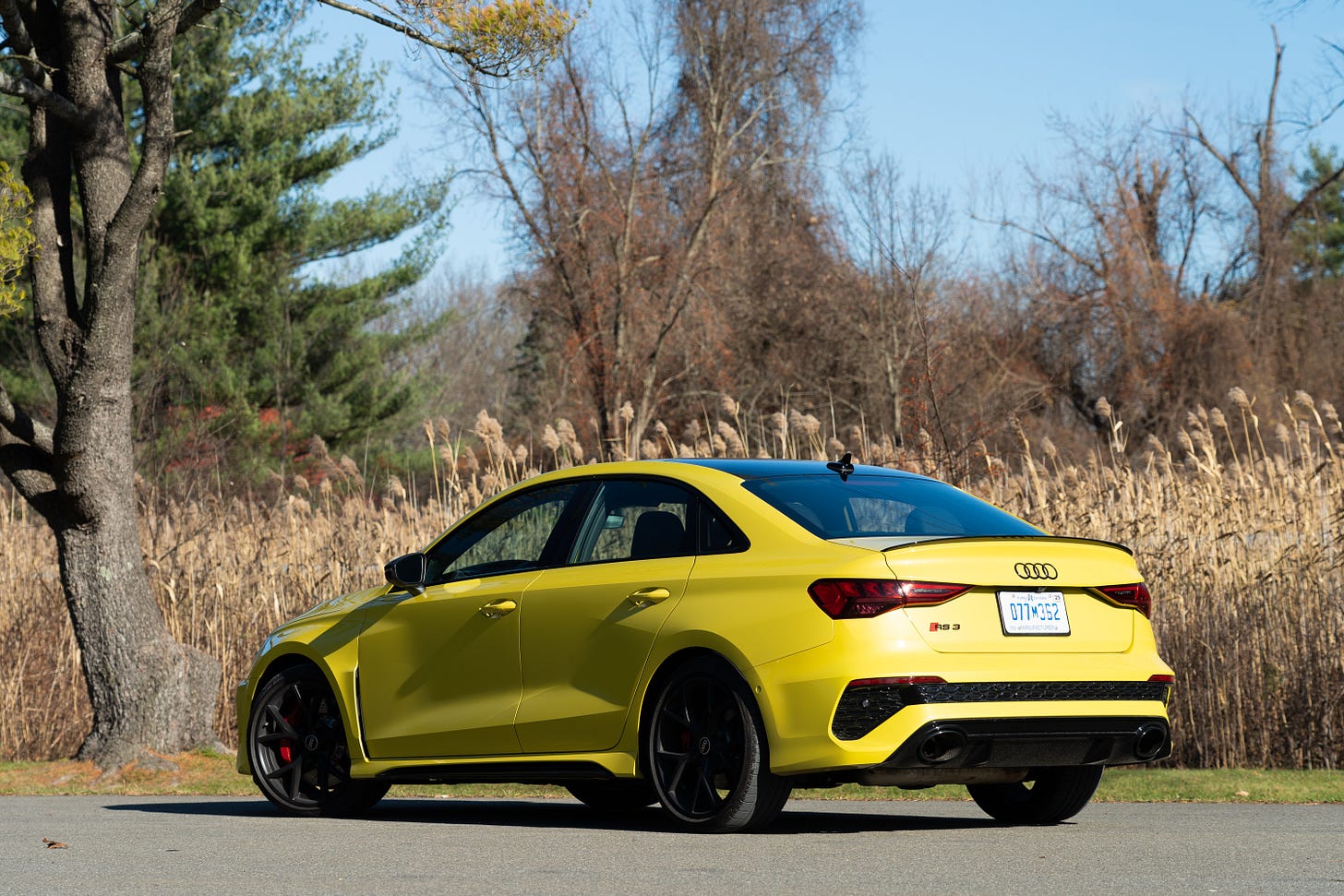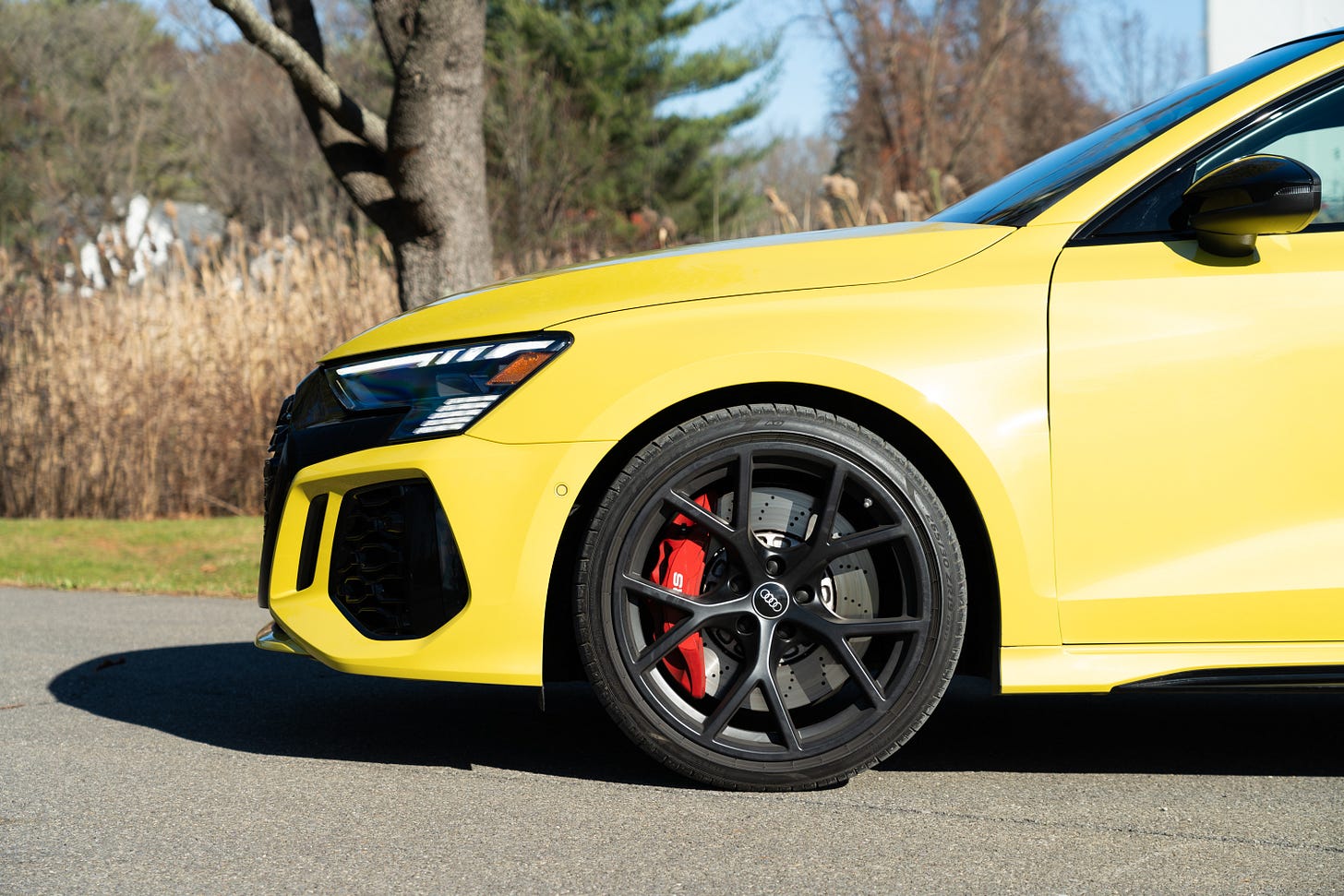Audi RS3 Review: Putting Down Torque in All The Right Places
Audi's RS3 sedan delights.
[Hi there, just a quick note before we dive in, since this is the first review I’ve sent through here. Finding homes for car reviews as a freelancer is getting a little harder these days, especially for those of the non-electrified cars. So, I hope you don’t mind my sharing some on here from time to time.]
The RS3 may be smaller than most of Audi's RS offerings, but don't let that be a mark against. While the RS5 offers big-speed in a grand-touring package and the RS6 Avant is a drool-worthy, Autobahn-conquering wagon, this latest generation of Audi's RS3 is much more than a relatively attainable, compact sedan with a lot of extra ponies. It has the look, the drive, and the poise to match.
My test car, outfit in Python Yellow metallic with Audi's Black Optic Plus package (a $750 option that blacks out the wheels, the logos, and even the roof), certainly makes a strong first impression. The yellow is just a fraction of a shade too light for my preferences, but it is a fetching hue, probably the most striking of the eight colors that Audi has on offer. But, with a stunning green, blue, and red also available, delightfully you're not just stuck with 7 shades of gray plus black.









Outside of the palette, the other augmentations to differentiate this from a lesser S3 or even A3 are subtle enough that a casual observer wouldn't look twice. For some that's a strong mark against, but I love how extensively modified the lines of this car are without creating something too shouty.
The best example, for me, are the subtle vents that run vertically along the trailing edges of the front fenders, just before the front doors. These thin, black highlights aren't even visible from the front or the side, but from the rear they really stand out as a distinctive throwback to touring car racers of yore.
In fact, many of the creases and shapes that define the car are difficult to spot, the fender flares and the other dramatic lines leading to and from the car's many vents and highlights. But, catch the light just right, park the car at an angle to the sun, and the geometric beauty of the sedan's lines really stand out.
On the inside, the RS3 shares a lot more with the more pedestrian A3 and S3, and I have to say I'm not a big fan of the design. Angular shapes and pods stand out from the dash all over, driver's vents perched higher than those for the passenger, bits of silver and piano-black plastic mixed with various types of rubbers and, for the RS3, a slender weave of carbon fiber just above the glove box. There are just too many shapes and surfaces for my tastes.
But the materials are generally good, and the RS steering wheel here is superb. Deep without being fat, petite without feeling small, it feels custom-molded for my hands. And, with plenty of physical controls, plus slender shift paddles on the back, just dropping into the 9-and-3 position on the wheel made me eager to go.
The front seats are likewise bespoke for the RS3, deep and supportive but still soft and comfortable, with the trademark hex quilting still looking fresh. Rear seats, too, are quilted, but anyone of more than moderate height is going to struggle to fit in them. Legroom is passable and headroom scant. There is, at least, a pair of USB-C connectors and 'dedicated HVAC controls.
Two more USB-C plugs sit down low in the center console up front, right next to a Qi wireless charging pad. Above that is Audi's venerable MMI. A slender row of HVAC controls rest below the 10.1-inch touchscreen that pairs with the 12.3-inch virtual dashboard gauge cluster and a heads-up display. The UI is reasonably comprehensive and snappy enough, offering wireless Android Auto and Apple CarPlay to boot. But the integrated navigation experience is solid, augmented by Google for point-of-interest searches and a better-than-respectable voice search.
Dig through the touchscreen and you'll find some further RS customizations, including a real-time look at your cars' various fluid temperatures, tire pressures, and even your all-time high values for the integrated G-meter. It's perfect for showing off at the skidpad. Most importantly, though, it's through the main display that you'll customize the car's various driving modes.
Comfort, Auto, and Dynamic are the three default modes, and they're pretty self-explanatory. More interesting are the three RS modes, accessible through the touchscreen or the dedicated RS button on the steering wheel. The RS Performance mode has a few customization options, while RS Individual has a lot, including settings for the center differential, engine and transmission, suspension, steering, exhaust, and traction control. With just a few taps I was able to choose my perfect mode -- all the power and suspension, maximum excitement from the center differential but the lightest steering resistance and quietest exhaust setting -- and then I hit the road.
I started in comfort, though, and on the highway, cruising over broken roads and just mingling in traffic, the RS3 is perfectly tame. That seven-speed DSG gearbox is a little rough sometimes when coasting to a stop, but by and large it's silky smooth cruising around town. There's a bit more road noise than you'd expect from an A3, thanks surely in large part to the low-profile, 19-inch tires, and when unstressed the engine does have a bit of a drone to it, but really these are minor complaints. It's a good commuter, made all the better by Audi's Pre Sense safety system. Adaptive cruise here did a stellar job of following traffic and keeping the car centered in its lane, while forward collision warning and avoidance should help to keep those insurance bills down.
Slot over to Dynamic mode and now things get more interesting. The exhaust opens up and the transmission drops down a gear, waiting there for you to get on it. This is likewise a great mode for daily driving when you're looking for a bit more engagement, but I confess I spent most of my time in one of the RS modes.
With the engine on full aggression and the rest of the drivetrain also amped up, the RS3 is a real joy to drive. While I found the last-gen RS3 to be engaging but occasionally reluctant when really hustled, this new RS3 rewarded my every input. The steering was light but sharp and, most importantly, the car reacted to those steering inputs with aggression. Eagerness was on display at every turn and, whenever grip was lost, it seemed to give way first at the rear.
Powering out of and through corners, intentionally pushing too hard to see where the grip would fail first, the RS3’s tail repeatedly stepped out. And that was without my selecting the third and final driving mode: RS Torque Rear. Here, the RS3 relies on its active differentials to send the bulk of the engine's power to the outside rear wheel. It’s a dramatic solution you needn’t rely upon to have a good time. That the car feels so lively even in the normal RS modes says a lot about the aggression of the tuning, both the suspension and the power delivery.
And yes, while I tend to prefer quieter cars, I spent quite a bit of time with the sport exhaust open. Even there the RS3 did not disappoint. Sporty Audis with odd numbers of cylinders typically have a distinctive, mechanical, sonorous song and the RS3 is a strong addition to that lineage. There's even a subtle, boomy pop from the exhaust with every gearshift. Despite the limited displacement and the forced induction, the RS3 sounds great.
And it moves quickly. 401 horsepower is not what it used to be, but the RS3's launch control is mighty impressive for a car in this category, sprinting to 60 in 3.6 seconds, and other than a healthy bit of turbo lag to be managed, the 2.5-liter inline five-cylinder engine is a delight.
It's even somewhat frugal for something this quick, EPA-rated at 23 combined. Likely thanks to my over-reliance on the right pedal, I did considerably worse, averaging 18.8.
The car you see here featured a few options, including the $2,750 RS Technology Package (with an upgraded B&O sound system and a heads-up display), $1,000 for the RS Sport Exhaust, $750 for the aforementioned Black Optic package, $350 for blind-spot monitoring, and $595 for the lurid paint. Add on a $1,095 destination and you have a final price of $65,440. This, though, was a 2022 model, and prices have increased slightly since.
That is a lot for a little sedan, and I dearly wish we had access to the hatchback flavor, but every time you dive deep in those drive modes and dive into your favorite sequence of corners, you'll know it was money well spent.






